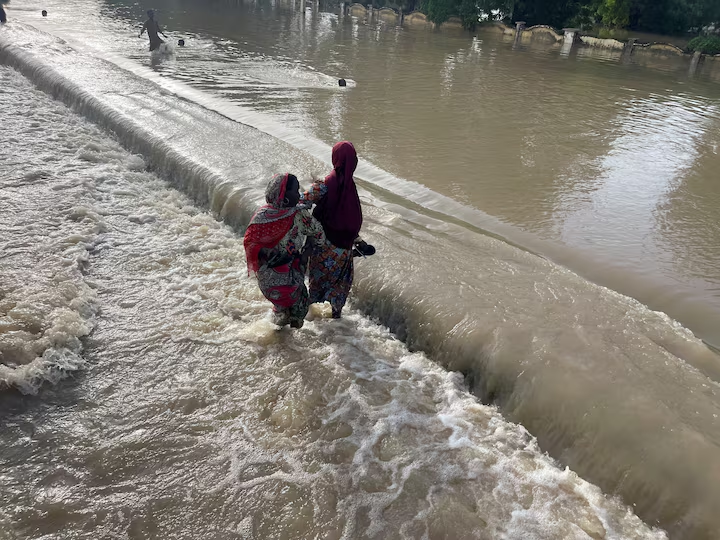In the face of an escalating risk of devastating floods, the Nigeria Hydrological Services Agency (NIHSA) has issued a critical warning to residents in flood-prone areas. The alarm follows the planned release of water from Cameroon’s Lagdo Dam into the Rivers Niger and Benue. NIHSA’s call to action comes with a sense of urgency, as the release of water could lead to widespread flooding across several states, including Adamawa, Taraba, and Kogi, Rivers State, Bayelsa State etc Given the destructive potential of this situation, the agency is imploring residents to relocate from high-risk areas to prevent loss of life and property.
The Lagdo Dam, located in northern Cameroon, was constructed in the 1980s for irrigation, power generation, and flood control purposes. However, its proximity to Nigeria’s river systems means that any significant release of water poses a serious threat to communities living along the Rivers Niger and Benue. NIHSA has explained that the release of water from the dam will be carried out intermittently. This controlled release is essential for managing water levels, but it also comes with the risk of causing dangerous flooding, especially in states downstream.
NIHSA’s warning specifically identified 11 states at immediate risk of flooding: Adamawa, Taraba, Benue, Niger, Kogi, Nasarawa, Anambra, Delta, Edo, Bayelsa, and Rivers. These regions are geographically susceptible due to their proximity to Nigeria’s major river basins, making them vulnerable to the effects of any increase in water volume.
The warning is particularly urgent given the recent flooding disaster in Maiduguri, where water released from the Alau Dam claimed over 30 lives and destroyed several homes. This tragedy serves as a stark reminder of the dangers that water releases can pose if proper precautions are not taken. Floods can devastate communities in a matter of hours, leaving behind trails of destruction that could take years to recover from.
Flooding in Nigeria is not a new phenomenon. In 2022, large portions of the country experienced catastrophic floods that displaced thousands and caused significant loss of life. This year, with the Lagdo Dam release compounding the risks, NIHSA’s warnings cannot be ignored. The situation calls for proactive measures to prevent a repeat of past tragedies.
NIHSA’s Call to Action In response to the looming threat, NIHSA has outlined a series of recommendations aimed at mitigating the impact of the floods. First and foremost, residents living in flood-prone areas, particularly along riverbanks and low-lying areas, are strongly advised to relocate to higher ground. This is a precautionary measure that could save countless lives as the water levels in the Rivers Niger and Benue rise.
NIHSA emphasized the importance of ensuring that drainages are cleared. Blocked or poorly maintained drainages can exacerbate flooding by preventing water from flowing freely, thereby increasing the risk of water pooling in residential areas. The agency also urged local governments and community leaders to educate residents about the risks of flooding and to coordinate efforts to ensure that those in danger receive adequate support and relocation assistance.
 While NIHSA’s warnings are crucial for addressing the immediate threat, there is also a need for a more long-term strategy to manage flood risks in Nigeria. Regular maintenance of river channels, effective flood management policies, and investments in drainage infrastructure are key components of reducing the vulnerability of flood-prone areas. The release of water from dams, both domestic and foreign, should be better coordinated with national hydrological services to ensure that residents receive timely warnings and adequate support.
While NIHSA’s warnings are crucial for addressing the immediate threat, there is also a need for a more long-term strategy to manage flood risks in Nigeria. Regular maintenance of river channels, effective flood management policies, and investments in drainage infrastructure are key components of reducing the vulnerability of flood-prone areas. The release of water from dams, both domestic and foreign, should be better coordinated with national hydrological services to ensure that residents receive timely warnings and adequate support.
Public awareness campaigns are equally important. Many communities living in high-risk areas may not fully understand the severity of the threat or may be reluctant to leave their homes due to economic constraints. It is essential that the government and non-governmental organizations (NGOs) work together to provide relocation assistance, ensuring that vulnerable populations are moved to safer areas before the floods strike.
The potential flooding from the release of water from Cameroon’s Lagdo Dam into the Rivers Niger and Benue presents a critical situation that requires immediate action. NIHSA’s warnings must be taken seriously by both residents and government authorities to prevent another disaster like the one in Maiduguri. With 11 states at risk, the call to clear drainages, relocate, and prepare for potential flooding is not just a precaution—it is a matter of life and death.
As the country faces yet another flood season, proactive measures are crucial to protect lives, homes, and livelihoods. It is now up to all stakeholders to heed the warnings, act swiftly, and implement both short- and long-term solutions to mitigate the effects of this impending natural disaster.




